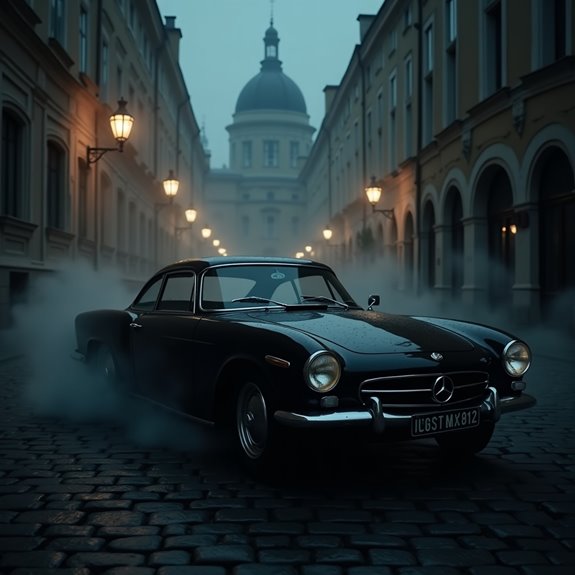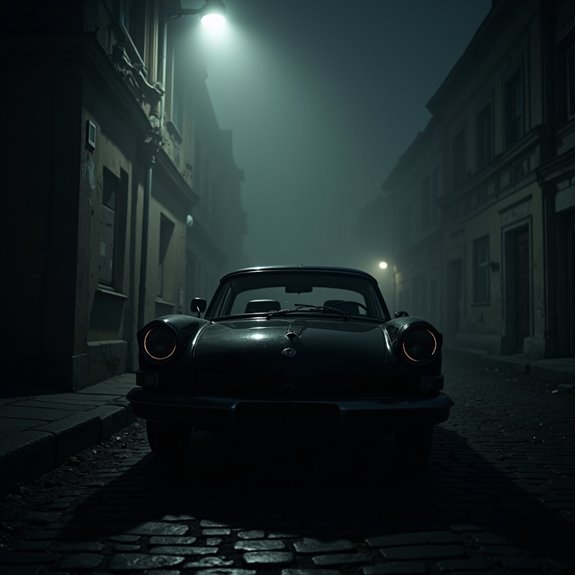The Legend of the Black Volga Car in Eastern Europe
The legend of the Black Volga car weaves a chilling narrative throughout Eastern Europe, especially during the Cold War years. This sleek vehicle, often associated with kidnappings, struck fear into the hearts of citizens. Sightings sparked urban myths, intertwining reality and superstition. As tales of its ominous presence grew, one has to wonder: what drove this vehicle to become a symbol of state oppression and fear?
Introduction

Though the Black Volga car is often shrouded in mystery, its legend has captivated the imaginations of people across generations. In the latter half of the 20th century, this eerie vehicle became synonymous with urban myths and fear. Many believed it served as a tool for secret police, involved in kidnappings and disappearances, fueling tales of state oppression. The sleek black design, paired with its exclusive status, added to its allure. While some dismissed the stories as mere superstition, others experienced real terror, spotting the Volga in their neighborhoods. Its presence seemed to symbolize the unseen power of the regime, blending intrigue and dread. As the legend grew, so did the fascination, embedding the Black Volga deeply into cultural folklore.
Cold War Propaganda Vehicle

While many associate the Black Volga with sinister folklore, it also served as a chilling symbol of Cold War propaganda. During this tense era, the car represented the power and reach of the Soviet regime. Authorities used the flashy vehicle to project an image of wealth and control, aiming to instill fear and compliance among citizens. Rumors circulated that it belonged to high-ranking officials, reinforcing the idea that the government was always watching. This perception turned the Black Volga into a tool of intimidation, suggesting that anyone who opposed the state could disappear without a trace. As whispers of its mysterious drivers spread, the car’s menacing aura resonated profoundly, etching itself into the collective memory of Eastern Europe during the Cold War.
Notable Cases or Sightings

As tales of the Black Volga spread, several notable sightings fueled its legend, capturing the imaginations of those who heard them. In the 1960s, a group of schoolchildren reported seeing the sleek black car slowly cruising through their neighborhood. They noted its peculiar shape and tinted windows, sparking fear among the children who believed it transported sinister figures. Another sighting occurred in a remote village where a villager claimed to have seen the car parked near a cemetery at midnight. Locals whispered of mysterious figures exiting the vehicle, adding to its ominous reputation. Even celebrities in the region shared chilling encounters, reinforcing the car’s association with abduction and intrigue. These stories kept the myth alive, influencing countless narratives over time.
Common Theories or Explanations
The chilling sightings of the Black Volga have led to various theories attempting to explain its mysterious presence. Some people believe it’s an omen of death, suggesting the car’s appearance signals tragedy or misfortune. Others theorize it’s connected to secret police activity, positing that it served as a tool for kidnappings or government surveillance during Soviet times. Some claim the vehicle is tied to mob activity, highlighting its usage as a getaway car after illicit dealings. There are also paranormal theories, with some suggesting the Black Volga is a ghostly apparition representing lost souls. Each theory reflects a mix of fear, superstition, and intrigue, contributing to the eerie legend that continues to captivate Eastern European folklore.
Frequently Asked Questions
What Does the Black Volga Symbolize in Popular Culture?
The Black Volga symbolizes mystery, fear, and the unknown in popular culture. It represents darker themes, societal anxieties, and urban legends that captivate imaginations, prompting discussions about morality, power, and the supernatural in modern storytelling.
Are There Any Films or Books About the Black Volga?
Yes, several films and books feature the Black Volga. These works explore its ominous significance, often revealing themes of fear and mystery, enchanting audiences with chilling narratives that reference the car’s dark folklore and cultural impact.
How Did the Myth Spread Across Eastern European Countries?
The myth spread across Eastern Europe as chilling stories circulated through word of mouth, local media, and folklore gatherings. Each telling entwined local fears and superstitions, transforming the narrative into a cultural phenomenon woven into societal consciousness.
Are There Any Urban Legends Related to the Black Volga?
Yes, urban legends about the Black Volga suggest it’s linked to mysterious disappearances and supernatural occurrences. Many believe it serves as a vehicle for sinister entities, fueling fear and intrigue across various Eastern European communities.
What Is the Black Volga’s Significance in Contemporary Society?
The Black Volga symbolizes societal fears and the unknown in contemporary society. It represents the intersection of urban legends and cultural myth, reflecting anxieties about crime, power, and morality that persist in modern narratives.


